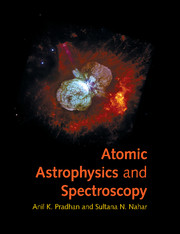Book contents
- Frontmatter
- Contents
- Preface
- Acknowledgements
- 1 Introduction
- 2 Atomic structure
- 3 Atomic processes
- 4 Radiative transitions
- 5 Electron–ion collisions
- 6 Photoionization
- 7 Electron–ion recombination
- 8 Multi-wavelength emission spectra
- 9 Absorption lines and radiative transfer
- 10 Stellar properties and spectra
- 11 Opacity and radiative forces
- 12 Gaseous nebulae and H II regions
- 13 Active galactic nuclei and quasars
- 14 Cosmology
- Appendix A Periodic table
- Appendix B Physical constants
- Appendix C Angular algebra and generalized radiative transitions
- Appendix D Coefficients of the fine structure components of an LS multiplet
- Appendix E Effective collision strengths and A-values
- References
- Index
10 - Stellar properties and spectra
Published online by Cambridge University Press: 05 June 2012
- Frontmatter
- Contents
- Preface
- Acknowledgements
- 1 Introduction
- 2 Atomic structure
- 3 Atomic processes
- 4 Radiative transitions
- 5 Electron–ion collisions
- 6 Photoionization
- 7 Electron–ion recombination
- 8 Multi-wavelength emission spectra
- 9 Absorption lines and radiative transfer
- 10 Stellar properties and spectra
- 11 Opacity and radiative forces
- 12 Gaseous nebulae and H II regions
- 13 Active galactic nuclei and quasars
- 14 Cosmology
- Appendix A Periodic table
- Appendix B Physical constants
- Appendix C Angular algebra and generalized radiative transitions
- Appendix D Coefficients of the fine structure components of an LS multiplet
- Appendix E Effective collision strengths and A-values
- References
- Index
Summary
Stars exist in great variety. They are among the most stable, as well as occasionally the most unstable, objects in the Universe. While extremely massive stars have short but very active lifetimes of only millions of years after birth, the oldest stars have estimated ages of up to 14 billion years at the present epoch, not much shorter (though it must be) than the estimated age of the Universe obtained by other means, such as the cosmological Hubble expansion. In fact, the estimates of the age of the Universe are thereby constrained, since the Universe cannot be younger than the derived age of the oldest stars – an obvious impossibility. Stellar ages are estimated using well-understood stellar astrophysics. On the other hand, variations in the rate of Hubble expansion may depend on the observed matter density in the Universe, the gravitational ‘deceleration parameter’, the ‘cosmological constant’, ‘dark’ (unobserved) matter and energy, and other exotic and poorly understood entities. Needless to say, this is an interesting and rather controversial area of research, and is further discussed in Chapter 14.
But stars are the most basic astronomical objects, and astronomers are confident that stellar physics is well-understood. This confidence is grounded in over a century of detailed study of stars, with the Sun as the obvious prototype. Most of this knowledge is derived from spectroscopy which, in turn, yields a wealth of information on nearly every aspect of stellar astrophysics; stellar luminosities, colours, temperatures, sizes, ages, composition, etc.
- Type
- Chapter
- Information
- Atomic Astrophysics and Spectroscopy , pp. 220 - 238Publisher: Cambridge University PressPrint publication year: 2011

